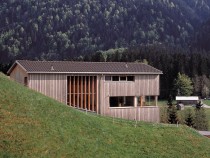
© Ignacio Martinez
The house stands on an exposed hillside site on the edge of Au, an unspoilt village in the Bregenz Forest in Austria. The simple form of the building, with a pitched saddle-back roof and timber-clad walls, adopts the traditional features of houses in the region. At the same time, it is also a prototype for a newly developed form of construction, consisting of diagonally dowelled timber elements. The panel-like components are made up of 60/100 mm solid squared timbers set parallel to each other, grooved and housed together, and fixed on the diagonal with hardwood dowels. Prefabricated components of this kind were used for the external walls, the floors and the roof. The storey-height wall units were delivered to site – complete with thermal insulation and timber cladding – as single elements extending over the full length of the house. Internally, the timber components are left exposed. To a large degree, it is their lively surface appearance that determines the spatial mood. To ensure a sense of continuity, the joints in the underside of the floor elements were aligned with those of the vertical wall timbers. By suspending the floor elements from tension rods fixed to a longitudinal roof truss, it was possible to create a column-free living space on the ground floor. Large areas of glazing open the house to the south, and the internal space is extended externally by protected verandas on the south and west faces.



